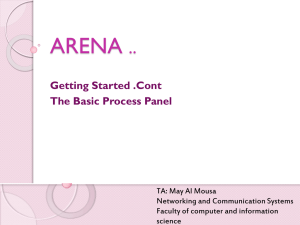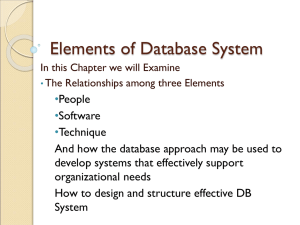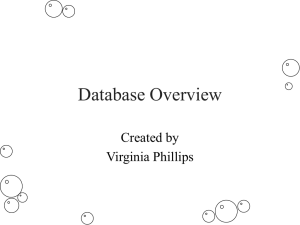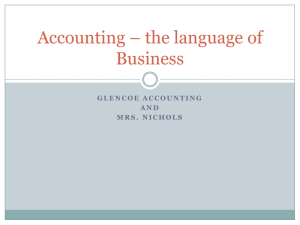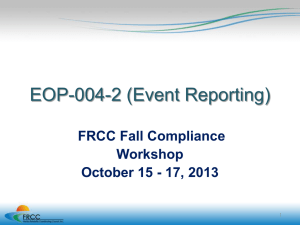The Entity Relationship Model
advertisement
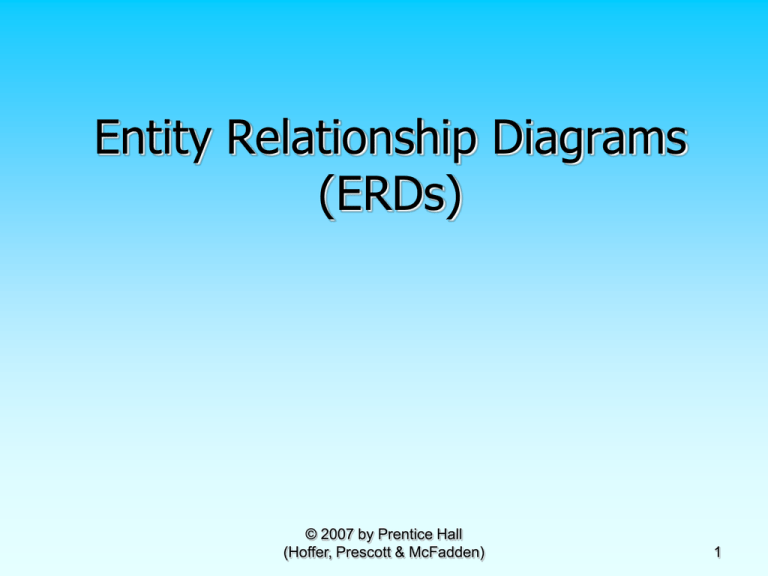
Entity Relationship Diagrams (ERDs) © 2007 by Prentice Hall (Hoffer, Prescott & McFadden) 1 E-R Model Constructs Entities: Relationships: Entity instance–person, place, object, event, concept (often corresponds to a row in a table) Entity Type–collection of entities (often corresponds to a table) Relationship instance–link between entities (corresponds to primary key-foreign key equivalencies in related tables) Relationship type–category of relationship…link between entity types Attribute–property or characteristic of an entity or relationship type (often corresponds to a field in a table) Chapter 3 © 2007 by Prentice Hall 2 Sample E-R Diagram (Figure 3-1) Chapter 3 © 2007 by Prentice Hall 3 Basic E-R notation (Figure 3-2) Entity symbols Attribute symbols A special entity that is also a relationship Relationship symbols Relationship degrees specify number of entity types involved Chapter 3 Relationship cardinalities specify how many of each entity type is allowed © 2007 by Prentice Hall 4 What Should an Entity Be? SHOULD BE: An object that will have many instances in the database An object that will be composed of multiple attributes An object that we are trying to model SHOULD NOT BE: A user of the database system An output of the database system (e.g., a report) Chapter 3 © 2007 by Prentice Hall 5 Figure 3-4 Example of inappropriate entities System user Inappropriate entities System output Appropriate entities Chapter 3 © 2007 by Prentice Hall 6 Attributes Attribute–property or characteristic of an entity or relationahip type Classifications of attributes: Required versus Optional Attributes Simple versus Composite Attribute Single-Valued versus Multivalued Attribute Stored versus Derived Attributes Identifier Attributes Chapter 3 © 2007 by Prentice Hall 7 Identifiers (Keys) Identifier (Key)–An attribute (or combination of attributes) that uniquely identifies individual instances of an entity type Simple versus Composite Identifier Candidate Identifier–an attribute that could be a key…satisfies the requirements for being an identifier Chapter 3 © 2007 by Prentice Hall 8 Characteristics of Identifiers Will not change in value Will not be null No intelligent identifiers (e.g., containing locations or people that might change) Substitute new, simple keys for long, composite keys Chapter 3 © 2007 by Prentice Hall 9 Figure 3-7 A composite attribute An attribute broken into component parts Figure 3-8 Entity with multivalued attribute (Skill) and derived attribute (Years_Employed) Multivalued an employee can have more than one skill Chapter 3 Derived from date employed and current date © 2007 by Prentice Hall 10 Figure 3-9 Simple and composite identifier attributes The identifier is boldfaced and underlined Chapter 3 © 2007 by Prentice Hall 11 Figure 3-19 Simple example of time-stamping This attribute that is both multivalued and composite Chapter 3 © 2007 by Prentice Hall 12 More on Relationships Relationship Types vs. Relationship Instances Relationships can have attributes The relationship type is modeled as lines between entity types…the instance is between specific entity instances These describe features pertaining to the association between the entities in the relationship Two entities can have more than one type of relationship between them (multiple relationships) Associative Entity–combination of relationship and entity Chapter 3 © 2007 by Prentice Hall 13 Figure 3-10 Relationship types and instances a) Relationship type b) Relationship instances Chapter 3 © 2007 by Prentice Hall 14 Degree of Relationships Degree of a relationship is the number of entity types that participate in it Unary Relationship Binary Relationship Ternary Relationship Chapter 3 © 2007 by Prentice Hall 15 Degree of relationships – from Figure 3-2 One entity related to another of the same entity type Chapter 3 Entities of two different types related to each other © 2007 by Prentice Hall Entities of three different types related to each other 16 Cardinality of Relationships One-to-One One-to-Many Each entity in the relationship will have exactly one related entity An entity on one side of the relationship can have many related entities, but an entity on the other side will have a maximum of one related entity Many-to-Many Entities on both sides of the relationship can have many related entities on the other side Chapter 3 © 2007 by Prentice Hall 17 Cardinality Constraints Cardinality Constraints - the number of instances of one entity that can or must be associated with each instance of another entity Minimum Cardinality If zero, then optional If one or more, then mandatory Maximum Cardinality The maximum number Chapter 3 © 2007 by Prentice Hall 18 Figure 3-12 Examples of relationships of different degrees a) Unary relationships Chapter 3 © 2007 by Prentice Hall 19 Figure 3-12 Examples of relationships of different degrees (cont.) b) Binary relationships Chapter 3 © 2007 by Prentice Hall 20 Figure 3-12 Examples of relationships of different degrees (cont.) c) Ternary relationship Note: a relationship can have attributes of its own Chapter 3 © 2007 by Prentice Hall 21 Figure 3-17 Examples of cardinality constraints a) Mandatory cardinalities A patient history is recorded for one and only one patient Chapter 3 A patient must have recorded at least one history, and can have many © 2007 by Prentice Hall 22 Figure 3-17 Examples of cardinality constraints (cont.) b) One optional, one mandatory A project must be assigned to at least one employee, and may be assigned to many Chapter 3 An employee can be assigned to any number of projects, or may not be assigned to any at all © 2007 by Prentice Hall 23 Figure 3-17 Examples of cardinality constraints (cont.) a) Optional cardinalities A person is is married to at most one other person, or may not be married at all Chapter 3 © 2007 by Prentice Hall 24 Figure 3-21 Examples of multiple relationships a) Employees and departments Entities can be related to one another in more than one way Chapter 3 © 2007 by Prentice Hall 25 Figure 3-21 Examples of multiple relationships (cont.) b) Professors and courses (fixed lower limit constraint) Here, min cardinality constraint is 2 Chapter 3 © 2007 by Prentice Hall 26 Figure 3-15a and 3-15b Multivalued attributes can be represented as relationships simple composite Chapter 3 © 2007 by Prentice Hall 27 Strong vs. Weak Entities, and Identifying Relationships Strong entities Weak entity exist independently of other types of entities has its own unique identifier identifier underlined with single-line dependent on a strong entity (identifying owner)…cannot exist on its own does not have a unique identifier (only a partial identifier) Partial identifier underlined with double-line Entity box has double line Identifying relationship links strong entities to weak entities Chapter 3 © 2007 by Prentice Hall 28 Identifying relationship Strong entity Chapter 3 Weak entity © 2007 by Prentice Hall 29 Associative Entities entity–has attributes An A When should a relationship–links entities together relationship with attributes instead be an associative entity? All relationships for the associative entity should be many The associative entity could have meaning independent of the other entities The associative entity preferably has a unique identifier, and should also have other attributes The associative entity may participate in other relationships other than the entities of the associated relationship Ternary relationships should be converted to associative entities Chapter 3 © 2007 by Prentice Hall 30 Figure 3-11a A binary relationship with an attribute Here, the date completed attribute pertains specifically to the employee’s completion of a course…it is an attribute of the relationship Chapter 3 © 2007 by Prentice Hall 31 Figure 3-11b An associative entity (CERTIFICATE) Associative entity is like a relationship with an attribute, but it is also considered to be an entity in its own right. Note that the many-to-many cardinality between entities in Figure 3-11a has been replaced by two one-to-many relationships with the associative entity. Chapter 3 © 2007 by Prentice Hall 32 Figure 3-13c An associative entity – bill of materials structure This could just be a relationship with attributes…it’s a judgment call Chapter 3 © 2007 by Prentice Hall 33 Figure 3-18 Ternary relationship as an associative entity Chapter 3 © 2007 by Prentice Hall 34 Microsoft Visio Notation for Pine Valley Furniture E-R diagram Different modeling software tools may have different notation for the same constructs Chapter 3 © 2007 by Prentice Hall 35


